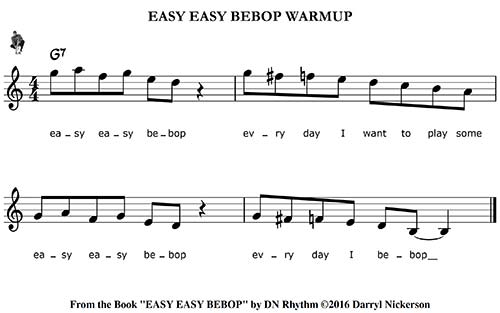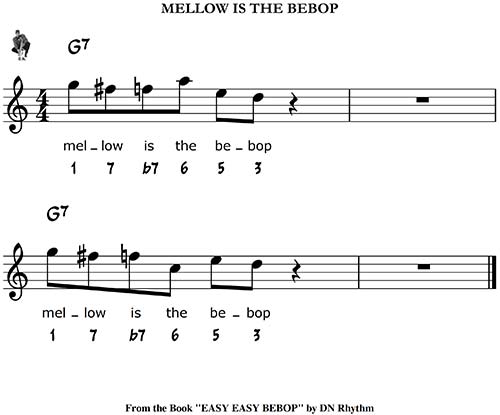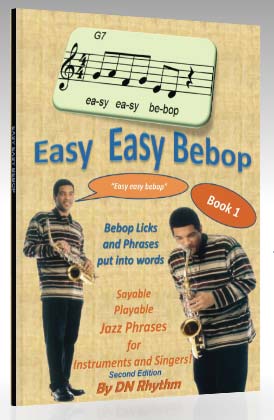-
So what you are telling me is that CST doesn't actually teach jazz? :-)
 Originally Posted by GuyBoden
Originally Posted by GuyBoden
Yes I'd agree with all of that. So you need workshop activities that support those things.
A point of philosophical divergence that might be controversial to some.
I think you have to choose between doing improvisation and teaching jazz (ie musical material) certainly at this stage. Barry's classes on improvisation included no actual improvisation yet taught me all I needed to know about building bop lines. So I'd be inclined to reframe this less as improv-in-the-moment and more as 'something of your own.' You can write it out if you want. I don't mind.
So the main constraint I'd place on students is not that they should improvise in the moment, but they should come up with something that sounds good to them.
I probably wouldn't take CST off the table in fact, as some seem to vibe with it, but I'd add, melodic variation, licks, I like Peter's exercise. Playing chord tones. Mix it up. Allow students to use their favourite approach. So long as they come up with something they are happy with.
But that's a small part of it. I'd use most of the time to make the group sound good as an ensemble, and learning melodies and heads by ear, learning to swing and phrase together, simple things for comping and so on. My focus would be on doing what you need to do to play the music well.
Everything should sound good. usually that will mean simple things done well. Blues, riffs, melodic variations and so on, all absolutely manageable at the lower levels. If it doesn't sound good, don't do it. No exceptions. (this is a concept form Situated Learning/apprenticeships). I would not be the final arbiter of taste of course but in my experience students are good critics of their own playing.
-
03-25-2024 10:32 AM
-
To go really beginner, here's an extract from a book I teach from. I mostly love this book. At this point they've learned six notes and already they are into syncopating and swinging and introducing the idea of the push. It's a twelve bar blues. The comping part for the book is 'bebop' blues changes, so it's legitimate sounding, especially when you play the melody with them to help them place the upbeats.
Getting them to sing the words helps them feel the melody too, engages the ear.
The improvisation side of it is a little CST-y in that it's 'here is this pitch set' (I cross out the B lol) - however it's quite interesting what strategies they come up with. With only 5 notes it's easier though.
Quite a few of the kids actually use the songs rhythm to improvise their blues ideas on. this works really well. So they basically came up with the Randy Vincent thing on their own. I though - "I'm having that" haha.
This makes me think that jazz and improv can be taught form the start, but you do need a well thought through repertoire of simple things to play. The other day I got a class of 30 kids playing 'C Jam Blues' by ear as a warm up. Sure it's only two notes, but so long as it swings.... (the challenge is the length of the rest between phrases of course)
you just need to grade the difficulty curve carefully. That's the challenge for the educator.
-
What is this book?
 Originally Posted by Christian Miller
Originally Posted by Christian Miller
-
Taking into account that a beginner must first learn functional tunes, I would strongly recommend soloing only with only 1 3 5 of each chord.
 Originally Posted by GuyBoden
Originally Posted by GuyBoden
I would exclude the 7ths (more precisely the b7 because normally it needs resolution to sound good and may sound weird if played randomly).
The logic is simple: if you cant control 3 notes, you will not control 7.
-
Guitar Basics - Longworth/Walker
 Originally Posted by pamosmusic
Originally Posted by pamosmusic
There's some small issues with it but mostly it's far and away better than anything else I've used so far.
-
Not at all, that's the point. If said teacher didn't like the system you were describing as not good then he could start a school with a different, better system. Why should it be worse?
 Originally Posted by Christian Miller
Originally Posted by Christian Miller
I don't know enough about this subject to engage with it fully but it seems you're talking mostly about institutions. Frankly, institutions worry me, especially educational institutions. Institutions are mirrors of the people organising and running them. With this world the way it is it would be a rare thing indeed to find an institution that was run on intelligent, enlightened thinking. Where there are human beings en masse the problems of ego come up to spoil things and we know where that leads, not that we've ever really solved it. So I'm wary beyond belief about institutions.No, of course, it's not that simple. There's all kinds of things at play here. Think of working for any organisation. Think of the context and the specificity of one's experience.
And it's not simply good/bad teacher.
Barry Harris was great teacher but I don't think he'd have done so well with a class of fairly non-committal preteens at Grade 5-8 on their instruments. You need a different kind of teacher and a different approach for different contexts. Some are good at multiple roles - others have mostly experience teaching at elite institutions and don't quite understand the world outside them, and so on.
Personally, no matter what the subject, I'd have small classes and teachers who actually knew how to teach. It would have to be almost a calling for them, not just a job. I'd also tend to want to vet the students, not just accept any old Tom, Dick or Harry. Nor would I fully separate the cerebral from the practical, I'd make sure the two were combined. I wouldn't want my students to be staring at a blackboard or memorising lists of stuff.
And so on. But to start a school like that takes initiative and money. Easy to talk about but doing it requires dedication. And it's rare, although I believe it has been done in the music world, though more with classical than jazz, probably. I suspect that it's precisely because it is so rare that we acquiesce to institutions and make the best of a questionable job.
It means what you said, that it doesn't require qualifications to be an internet mouth.Was that intended to be clever? Maybe you can explain it to me as I am quite dim.
-
Ahhhhhhhhhh
 Originally Posted by ragman1
Originally Posted by ragman1
This is one of those things that tends to say more than the speaker intends.
Short version: I think a lot of teaching gets stamped as “good” because the institution was selective in the first place. Was the teaching good, or is a crop of excellent students who don’t require much help making the teaching look good.
Shorter version: teaching really smart engaged students is relatively easy.
-
No, it's highly productive for all concerned.
 Originally Posted by pamosmusic
Originally Posted by pamosmusic
-
The simplest is just playing without naming anything.
 Originally Posted by Christian Miller
Originally Posted by Christian Miller

I know it's different when you are teaching someone.
What a monster thread! I'm way behind on page two.
-
“Highly productive” and “relatively easy” are not mutually exclusive. Actually if you’re performing a task that is relatively easy, then you’re more likely to be productive, I would think.
 Originally Posted by ragman1
Originally Posted by ragman1
And this is also a value judgement. What’s the goal? To produce fifteen stellar musicians that will make recordings we can listen to and enjoy? Then yes … audition and polish only the very finest.
Or is the goal to give as many people as want it, a decent education in music and help them learn to do it reasonably well and understand and enjoy it? If that’s the goal then auditioning a class of young students might be counterproductive.
-
I don't get the crux of the argument between chord tone/arp and chord scale.
In the case of a tonic type chord (and I'll post in the key of C rather than numerals) you have C E G A B D. Nice tonic sound. Six notes. The seventh note in the usual chord scale is F and that's the avoid note. I'll pause while there's an argument about that term.
Ok, we're back. Levine also called it a "handle with care" note. The point is, the chord tones with the 6 7 and 9 make a hexatonic scale and the extra note in the underlying tonal center is the one that you're supposed to "handle with care".
For a dominant, you might have G B D F and two more notes, maybe A and E or maybe tensions. Whatever. You end up with a hexatonic again and the seventh note would be the C -- "handle with care".
If you then ignore chord tones and apply a list of scales you got from someplace, in each case you're likely to have a 6 note chord embedded in the scale and one more note, which in the case of major and natural minor harmony is going to be the "handle with care" note.
In melodic minor harmony you can still get 6 notes from the chord tones and obvious extensions. Cminmaj7, for example, C Eb G B -- D and A work for the tonic sound (taking a slight liberty to note that Cminmaj7 and Cm6 are both melodic minor tonic sounds). The last note is F which is probably the last note you'd want to add to Cminmaj7 or Cm6. Once again, thinking chord tones is more or less equivalent to thinking hexatonic.
ii V I in C? Think C tonal center and put the chord tones (6 of them) on the downbeats.
.
iim7b5 V7b13 im? Same approach. Or, to the extent that I might think about it, I think C General Minor (my term) C D Eb F G Ab A Bb B. And then I leave out the notes that don't sound good. Or is the idea to specify every note in theory and omit any reference to making choices by ear?
My point, at long last, is that I don't see all that much difference between the two approaches (CST vs chord tones). The chord tones give you most of the notes and the missing one is often not one that's fully consonant.
One thing I wonder about is if the scale based approach appeals to those who need the fingering pattern to find the notes they want. Not a knock. There's an advantage to well practiced patterns when playing at a high tempo. But, if you know the notes in the chords you use (all 6 of them, where that applies) you can find the notes you want without memorizing dots on grids.
-
If you were a teacher of exemplary students would you be happy thinking 'This is easy'? I'd call you a bad teacher and the students would know. It means both push for excellence and excellence means hard work on both their parts.
 Originally Posted by pamosmusic
Originally Posted by pamosmusic
That's right.What’s the goal? To produce fifteen stellar musicians that will make recordings we can listen to and enjoy? Then yes … audition and polish only the very finest.
Exactly.Or is the goal to give as many people as want it, a decent education in music and help them learn to do it reasonably well and understand and enjoy it? If that’s the goal then auditioning a class of young students might be counterproductive.
-
Reminds me of the beginners book, 'Easy, Easy Bebop', where you sing easy phrases.
 Originally Posted by Christian Miller
Originally Posted by Christian Miller
https://www.bestsaxophonewebsiteever...as-a-language/
These:



-
Thanks Guy! That sounds like my sort of thing.
 Originally Posted by GuyBoden
Originally Posted by GuyBoden
Sent from my iPhone using Tapatalk
-
Ahhhh yes
 Originally Posted by pamosmusic
Originally Posted by pamosmusic
The kind of teaching where you don’t actually have to do any teaching?
Look, if I had that option I’d take it. I shan’t judge.
Sent from my iPhone using Tapatalk
-
It isn't an either or. The greats associate scales with chords and use scales in their playing, so cst should be included if you agree to any sort of methodical approach. However that isn't the whole picture. You need to learn vocabulary from ear work. You need to understand phrasing - short motifs, longer lines, and you need to understand melody shape besides only scalar. Melody is also shaped with arps, it is ornamented with chromatic devices, and there are wider intervals for excitement. So the best way to learn jazz is an overview that accurately describes how to compose it. Not a partial view, and not a metaphysical view.
 Originally Posted by GuyBoden
Originally Posted by GuyBoden
What are they? Originally Posted by Christian Miller
Originally Posted by Christian Miller
BH is pretty complete for jazz melody building. It outlines scalar stuff, chromatic stuff, and arp stuff. Throw in intervals and you're pretty much gold with how jazz melody is actually composed in the wild.Just for one week, go full Barry. See what happens.
-
He was yanking my chain because I was talking about teaching little kids.
 Originally Posted by Jimmy Smith
Originally Posted by Jimmy Smith
Alright Timmy … C7 scale from the root up the diminished from the third and then a little bee boo bee doo dah …
-
Haha, I see.
-
 Originally Posted by GuyBoden
You are quoting me out of context.
Originally Posted by GuyBoden
You are quoting me out of context. Originally Posted by Jimmy Smith
Originally Posted by Jimmy Smith
Yesterday, I was asking about 'beginners' learning Jazz.
Note, how the word 'beginners' is clearly shown in my quote below. I've highlighted the word in bold, so you might see it more clearly.
But, maybe, your answer for a 'beginners' approach would be the same. Originally Posted by GuyBoden
Originally Posted by GuyBoden

-
Ok, I see. For beginners to start with, I might prioritize some of the things you guys were talking about, but I would work toward the full picture in a reasonable amount of time.
-
Beginners on the guitar or beginners at jazz? At what age? One-on-one tuition or a class?
-
@Jimmy - a common complaint is ‘I know all the theory but I don’t sound like jazz’
Sent from my iPhone using Tapatalk
-
Haha, better get to transcribing. Although pinpointing the weaknesses with applied theory can tune things up as well. One can have all their base theory down and theory can still be used to explain how to correct what they're not doing right.
-
Yeah and in my experience the problem is the following, in this order:
 Originally Posted by Christian Miller
Originally Posted by Christian Miller
1. swing/time feel
2. idiosyncratic vocabulary, not really talking about big lines, but more the little pieces, along the lines of the 5-4-3-2 and that sort of thing.
3. Hitting the changes.
So transcribing and learning short licks is the big fix for the first two. And helps for the third.
-
 Originally Posted by Jimmy Smith
For example, when I did the thread on time feel and someone posted the lesson about how to theoretically understand good time feel, it really helped me.
Originally Posted by Jimmy Smith
For example, when I did the thread on time feel and someone posted the lesson about how to theoretically understand good time feel, it really helped me. Originally Posted by pamosmusic
Originally Posted by pamosmusic




 Reply With Quote
Reply With Quote







a script for a comic jazz session bit.
Today, 01:54 PM in Everything Else